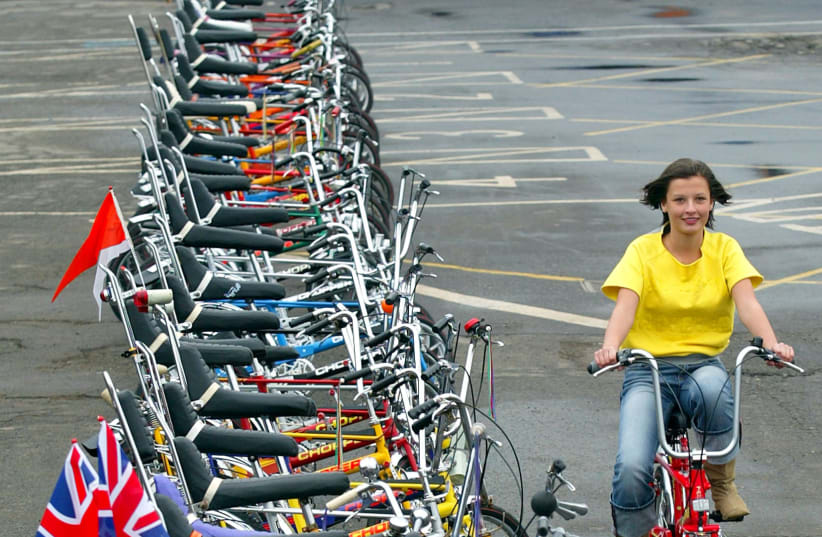What a fresh and fun basis for a work of historical fiction: A sensational 15-month around-the-globe cycling journey by Annie Cohen Kopchovsky, a young Boston mother motivated by the lure of a $10,000 prize – and, no less, the chance to escape the drudgery of marriage and motherhood.
Reinventing herself as “Annie Londonderry” so as not to sound too Jewish, Annie kicked off her adventure before a crowd of 500 onlookers at the Massachusetts State House on June 25, 1894.
She became a symbol for women’s suffrage and independence as she gradually shed her impractical skirts and demonstrated physical endurance, a keen head for business and a plucky ability to fend for herself in a man’s world.
Along the way, Annie meets such towering personalities as Susan B. Anthony, Annie Oakley and “Buffalo Bill” Cody. She earns her way by selling photographs of herself, giving lectures and performances and renting out advertising space on her riding suit and bicycle.
The novel, written by the great-grandson of Annie’s brother Bennett, puts her story in the first-person context of a long letter to her only granddaughter, Mary, to be opened when Mary turns 30.
I found the premise delightfully different and sped through the first half of the book with great enjoyment. However, as Annie’s travels wore on, my patience with her wore thin.
If Peter Zheutlin hadn’t been writing about a real person, he likely would have introduced some process of change, epiphany or redemption in his protagonist. Instead, he was confined to chronicling a colorful but unlikeable character who only gets more unlikeable with every turn of her wheels.
Annie’s journey is full of adventure and derring-do that’s fun and interesting to read about, but it doesn’t transform her. She is at least as selfish, conniving and deceitful at the end of the story as she is at the start.
In the skillful hands of her great-grandnephew, Annie acknowledges her faults and even exhibits some glimmers of guilt but never is inspired to better herself. She excuses her cheating and infidelities, her emotional and physical distance from her family, as necessary to advance the cause of the “New Woman” and banishing her own boredom.
But although she made quite a splash in her day, as evidenced by the actual newspaper clippings the author shares, Annie ultimately was forgotten. Unlike her heroes Nellie Bly and Susan B. Anthony, she did not contribute anything of lasting value to society and certainly not to her family.
“Many found my unabashed storytelling and willingness to sell myself to advertisers vulgar. But they were missing the point,” Annie writes to Mary. “Fame and notoriety, and hopefully the riches that would follow, though welcome, were not my primary ambitions. I was after the freedom of being a woman about the world, liberated from the pedestrian and soul-crushing demands of wifery and motherhood. And in all of this I was succeeding beyond my wildest dreams!”
Zheutlin is to be credited for resurrecting this neglected story – first in a nonfiction book titled Around the World on Two Wheels that spurred a documentary, two musicals, museum exhibitions and articles – and now in this novel.
There’s even an Israeli connection here: Zheutlin had an 1890-era Sterling bicycle, just like Annie’s, restored and loaned it to a traveling exhibition on women and cycling that started at the Bloomfield Science Museum in Jerusalem in 2017.
He writes in an afterword that he was at first disappointed and then charmed by Annie’s “utter unpredictability, her willingness to tell any story, no matter how far-fetched, to advance her celebrity. There may have been something pathological afoot, but I preferred to see her as my eccentric great-grandaunt… like the ditzy older women in Arsenic and Old Lace.”
The tall tales Annie spins are indeed charming and rather harmless, providing entertainment for audiences wherever she goes. But ditzy she was not. Her every move was planned with forethought and precision.
Perhaps the true message of Annie’s story – both the real and the embellished versions – is found in these words the author attributes to her:
“Yes, I told stories about places I had never been, contradictory accounts of how I had reached Japan from Marseille, and it should have been obvious, as it was to some, that no one on a bicycle could have covered such a great distance in so little time. But the lesson I learned was this, Mary: never underestimate the power of the mind to see what it wants to see and to believe what it wants to believe. Yes, the chorus of skeptics was growing, but for the most part people wanted to believe, and so they did.
“Perception has a way of becoming reality.”
SPIN: A NOVEL BASED ON A (MOSTLY) TRUE STORYBy Peter ZheutlinPegasus Books
